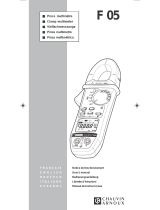
353/355
Users Manual
2
Safety Information
XWWarnings: Read First
To avoid possible electric shock or personal
injury:
• Use the Meter only as specified in this
manual or the protection provided by the
Meter might be impaired.
• Avoid working alone so assistance can
be rendered.
• Never measure ac current while the test
leads are inserted into the input jacks.
• Do not use the Meter in wet or dirty
environments.
• Do not use the Meter if it appears
damaged. Inspect the Meter before use.
Look for cracks or missing plastic. Pay
particular attention to the insulation
around the connectors.
• Inspect the test leads before use. Do not
use them if insulation is damaged or
metal is exposed.
• Check the test leads for continuity.
Replace damaged test leads before using
the Meter.
• Have the Meter serviced only by qualified
service personnel.
• Use extreme caution when working
around bare conductors or bus bars.
Contact with the conductor could result
in electric shock.
• Do not hold the Meter anywhere beyond
the tactile barrier. See Figure 1.
• When measuring current, center the
conductor in the clamp. See Figure 1.
• Do not apply more than the rated voltage,
as marked on the Meter, between the
terminals or between any terminal and
earth ground.
• Remove test leads from the Meter before
opening the Meter case.
• Never operate the Meter with the back
cover removed or the case open.
• Never remove the back cover or open the
case of an instrument without first
removing the test leads or the jaws from
a live conductor.
• Use caution when working with voltages
above 30 V ac rms, 42 V ac peak, or 60 V
dc. These voltages pose a shock hazard.
• Do not attempt to measure any voltage
that might exceed the maximum range of
the Meter- 600 V rms and 1 kHz or 1000 V
dc.
• Use the proper terminals, function, and
range for your measurements.




















